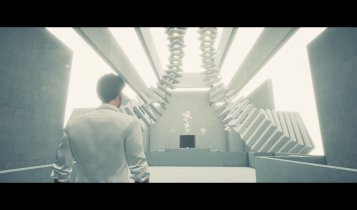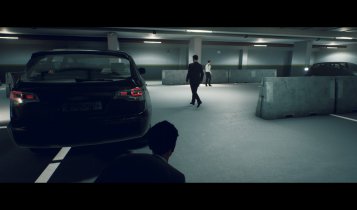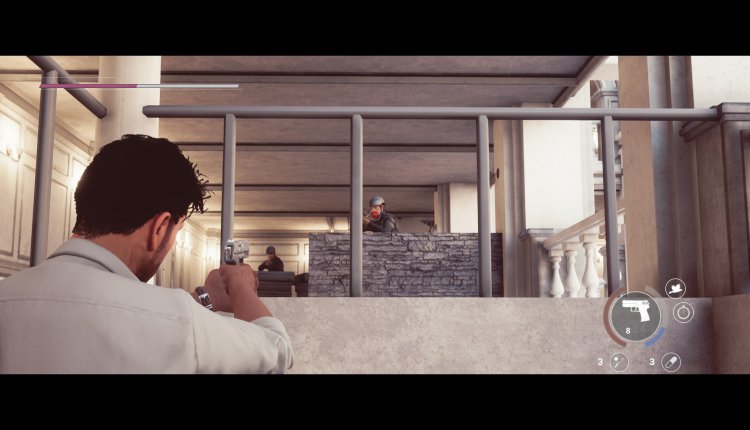Review | Past Cure
Welcome to Past Cure, in which you constantly question what’s real, what’s not and what’s actually happening.
Third-person, narrative-driven, science fiction games with solid shooting mechanics are something I really enjoy. I know that sounds fairly niche, but Alan Wake, Quantum Break and Dead Space are some of my favourite games thanks to their engaging stories being paired with good controls and a cinematic presentation. I’m not kidding when I say niche, though, as good games falling into those categories aren’t all too easy to find these days — so Past Cure was something that interested me when I took a look at its preview build not so long ago. Well, now I’ve had the chance to play the full game (pre-release), and here’s what happened.

We begin by taking on the role of Ian as he awakes in a bizarre, seemingly burned house with furniture on the floors… and ceilings. Confused (as I was), Ian explores, finds a gun, and is attacked by porcelain mannequins. Having dispatched them, he vanishes and appears in a black hall with a woman standing in a golden doorway, calling to him. As soon as Ian reaches her, he wakes up in a beach house. We discover that Ian is prone to recurring nightmares and visions due to mysterious events from his past, as well as encountering his ability to project his mind and manipulate time. Once he has explored the house, Ian receives a call from Marcus, his brother, telling him about a gang shipping a drug called Nexus. It may be a lead in the investigation into his past. Confused yet? You haven’t seen anything! As the game progresses, we find out about child testing, conspiracies, super-powered drugs and all sorts of other things. It’s incredibly convoluted and by the end, there were a huge number of plot threads left loose, as well as a twist which just raises more questions.
So, Past Cure’s story was a bit of a bust, which is a pity as it had the potential to be very interesting. The idea of Ian’s dreams/nightmares bleeding into reality was nice, but rarely explored. Ian’s past could be something fascinating, but remained more than a little muddy by the conclusion. Plots for most characters are brought up and then completely dropped. Who was the woman to Ian? Where did Marcus go? What about Dr. Fletcher’s past? If you play the game, you may be able to answer these questions yourself, but I had no clue by the end.
How about the gameplay, then? This is a third-person action game, for the most part, meaning shooting, melee and stealth in various measures. In most of the real-world sections, gunfights and melee are the main ways to progress. Environments contain enemies equipped with pistols, shotguns, machine guns or their fists and will need to be dispatched using those same things. The gunplay is functional, although nothing particularly special; right-click to aim, left-click to fire, R to reload and such. I felt the range of weapons was very limited, but considering the real-world setting, it made sense that there wouldn’t be much beyond that on offer. Melee is fairly enjoyable, with a strike/counter system that has been seen in a number of third-person games in recent years. Strikes lead to a finishing blow which looks good and is satisfying to pull off, whilst counters push the enemy back, letting you capitalise on this. Ian’s abilities can help in these parts of the game, with Astral Projection allowing him to find where enemies may be hiding and Time Manipulation letting him slow down time for those all-important headshots.

Stealth is an option most of the time and is fairly satisfying to use. For the most part, it works well, with enemies not seeing you when they shouldn’t and Ian’s abilities helping you find ways to take down opponents without being seen, as well as disabling cameras that would lead to reinforcements. The take-downs are a little odd, as some animations are much longer than others — sometimes you end up being spotted whilst Ian faffs about with a chokehold rather than a swift knife kill. This is all the more annoying in the single (quite lengthy) mandatory stealth section that comes between two optional stealth sections. I was spotted multiple times in this part of the game and became quite familiar with patrol patterns from having to replay it over and over.
The nightmare levels are quite different and are more puzzle-based. Whilst there are stealth sections, the enemies can’t be killed (most of the time) and you won’t immediately fail if spotted. Most of the puzzles were fairly simplistic, but this part of the game was probably the most enjoyable due to its interesting presentation and made greater use of Ian’s special abilities. Enemy encounters are brief (which is for the best, as there are very few character models) but fairly tense due to the fact that they can kill you in one attack. The increasingly creepy environments develop a good atmosphere and I was caught off guard by one or two jump scares.
The presentation of the nightmares was very creative too. From the early, pure white chambers filled with interesting geometric shapes to the grimy industrial areas later on, the environment is continually interesting to look at. Inversely, the real world is less interesting, mostly based in a tower block and a multi-storey car park. What is impressive, though, is Past Cure’s animation in cutscenes. Most of the time the characters look great and interact with each other and the environment well. There are a few choreographed fight scenes that look particularly impressive, as well as some very good facial animations. I get the feeling that this is where the bulk of the game’s development time went.
The same can’t be said for the voice work, which seems quite inconsistent. Ian lacks any sense of emotion during most of his dialogue (internal or otherwise), whilst Amos comes across as much too theatric. The sound mixing doesn’t help here, as voices are often drowned out by music or incidental sound. More irritating still is the fact that the subtitles aren’t timed to the voices, so I can’t even pick up what’s being said that way. This is something that may be fixed with a promised day-one patch, and I hope it is!

In spite of all this, you can tell that a lot of love went into creating Past Cure. This isn’t just some asset flip released to try to get some easy money; Phantom 8 clearly wanted to make something special but just couldn’t quite pull it off. There’s obviously a plan for a much bigger story that just doesn’t pan out, as well as tremendous talent for animation. There’s clear inspiration from major development studios who make third-person, narrative-driven games — this small (eight-person at the time) studio just couldn’t manage to compete with such large teams of developers. I genuinely hope they continue to develop games, as they have huge potential to make something excellent if they reduce their scope somewhat. I look forward to their future attempts.
Comments are closed.